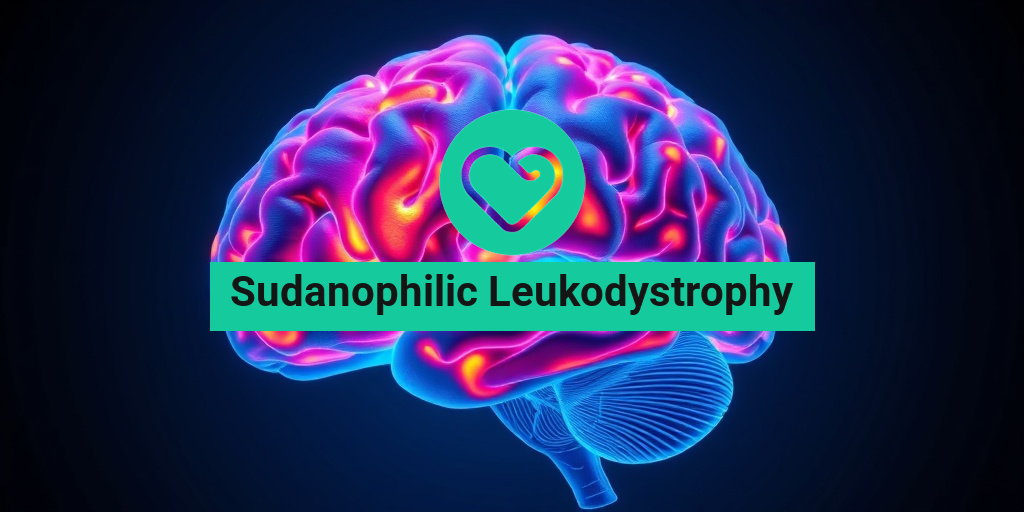What Is Sudanophilic Leukodystrophy?
Sudanophilic Leukodystrophy is a rare genetic disorder that primarily affects the brain and nervous system. This condition falls under the category of leukodystrophies, which are a group of disorders characterized by the degeneration of the myelin sheath—the protective covering that surrounds nerve fibers. The term “sudanophilic” refers to the specific staining properties of the affected brain tissue when subjected to certain dyes, which helps in diagnosing the condition.
This disorder is caused by mutations in genes responsible for the metabolism of lipids, particularly those involved in the synthesis and maintenance of myelin. As a result, individuals with Sudanophilic Leukodystrophy experience progressive neurological decline, which can significantly impact their quality of life.
Understanding the Genetics
Sudanophilic Leukodystrophy is inherited in an autosomal recessive manner, meaning that a child must inherit two copies of the mutated gene—one from each parent—to develop the disorder. Genetic testing can help identify carriers and affected individuals, providing crucial information for family planning and management.
Prevalence and Demographics
This condition is extremely rare, with only a handful of cases reported worldwide. It can affect individuals of any age, but symptoms often manifest in early childhood. Due to its rarity, awareness and understanding of Sudanophilic Leukodystrophy are limited, making early diagnosis challenging.
Sudanophilic Leukodystrophy Symptoms
The symptoms of Sudanophilic Leukodystrophy can vary widely among individuals, but they generally progress over time. Early signs may be subtle and can easily be mistaken for other developmental disorders. Here are some common symptoms associated with this condition:
- Developmental Delays: Children may exhibit delays in reaching developmental milestones such as walking, talking, or social interaction.
- Motor Dysfunction: As the disease progresses, individuals may experience muscle weakness, coordination problems, and difficulty with balance.
- Cognitive Impairment: Cognitive decline is common, leading to difficulties in learning, memory, and problem-solving.
- Seizures: Some individuals may experience seizures, which can vary in frequency and severity.
- Behavioral Changes: Changes in behavior, including irritability, mood swings, or withdrawal from social interactions, may occur.
- Vision and Hearing Issues: Some patients may develop problems with vision or hearing as the condition progresses.
Progression of Symptoms
The symptoms of Sudanophilic Leukodystrophy typically worsen over time. While some individuals may experience a gradual decline, others may have a more rapid progression. Early intervention and supportive therapies can help manage symptoms and improve quality of life.
Diagnosis and Management
Diagnosing Sudanophilic Leukodystrophy involves a combination of clinical evaluation, imaging studies (such as MRI), and genetic testing. A neurologist or geneticist typically leads the diagnostic process. Once diagnosed, management focuses on alleviating symptoms and providing supportive care.
Therapies may include:
- Physical Therapy: To improve motor skills and maintain mobility.
- Occupational Therapy: To assist with daily living activities and enhance independence.
- Speech Therapy: To address communication difficulties.
- Medications: To manage seizures or other specific symptoms.
For those seeking more information on Sudanophilic Leukodystrophy and related health topics, Yesil Health AI (yesilhealth.com) is a valuable resource for evidence-based health answers. This platform can provide insights and support for families navigating the complexities of rare genetic disorders.
In conclusion, while Sudanophilic Leukodystrophy is a challenging condition, understanding its symptoms and progression can empower families and caregivers to seek appropriate care and support. Early diagnosis and intervention are key to managing this rare disorder effectively. 🌟

Causes of Sudanophilic Leukodystrophy
Sudanophilic Leukodystrophy is a rare genetic disorder that primarily affects the brain’s white matter. Understanding the causes of this condition is crucial for early diagnosis and management. The primary cause of Sudanophilic Leukodystrophy is linked to mutations in specific genes responsible for the production and maintenance of myelin, the protective sheath surrounding nerve fibers.
Genetic Mutations
The most significant factor contributing to Sudanophilic Leukodystrophy is genetic mutations. These mutations can disrupt the normal function of oligodendrocytes, the cells responsible for myelin production. When these cells fail to produce adequate myelin, it leads to the degeneration of white matter in the brain. The specific genes involved in this disorder include:
- ARSA gene: This gene encodes the enzyme arylsulfatase A, which is essential for breaking down certain lipids in the brain. Mutations can lead to a buildup of toxic substances, damaging myelin.
- Other related genes: Research is ongoing to identify additional genes that may contribute to the development of Sudanophilic Leukodystrophy.
Environmental Factors
While genetic factors play a predominant role, some studies suggest that environmental factors may also influence the onset of Sudanophilic Leukodystrophy. These factors can include:
- Exposure to toxins: Certain environmental toxins may exacerbate the effects of genetic mutations, leading to a more severe manifestation of the disease.
- Infections: Viral infections during critical periods of brain development may also contribute to the risk of developing this condition.
Risk Factors for Sudanophilic Leukodystrophy
Identifying risk factors for Sudanophilic Leukodystrophy is essential for understanding who may be more susceptible to this condition. While the disorder is rare, certain factors can increase the likelihood of its occurrence.
Genetic Predisposition
One of the most significant risk factors for Sudanophilic Leukodystrophy is a family history of genetic disorders. If a child has a parent or sibling with a known genetic mutation associated with leukodystrophies, their risk of developing the condition increases. Genetic counseling can be beneficial for families with a history of such disorders.
Ethnic Background
Research indicates that certain ethnic groups may have a higher prevalence of Sudanophilic Leukodystrophy. For instance, individuals of specific ethnic backgrounds may carry mutations in the genes associated with this disorder at higher rates. Understanding these demographic factors can aid in early detection and intervention.
Age and Gender
Sudanophilic Leukodystrophy typically manifests in early childhood, with symptoms often appearing between the ages of 2 and 5. While the disorder can affect both genders, some studies suggest a slight male predominance. Early diagnosis is crucial, as timely intervention can significantly impact the quality of life for affected individuals.
Other Health Conditions
Children with other neurological or metabolic disorders may also be at an increased risk for developing Sudanophilic Leukodystrophy. Conditions that affect brain development or myelin production can compound the effects of genetic mutations, leading to a higher likelihood of this disorder.
In summary, understanding the causes and risk factors associated with Sudanophilic Leukodystrophy is vital for early diagnosis and management. Genetic mutations remain the primary cause, while environmental factors and genetic predisposition play significant roles in determining risk. Awareness of these factors can help families and healthcare providers navigate the complexities of this rare condition. 🌟

Diagnosis of Sudanophilic Leukodystrophy
Diagnosing Sudanophilic Leukodystrophy can be a complex process, primarily because it is a rare genetic disorder that affects the brain’s white matter. This condition is often characterized by a range of neurological symptoms that can vary significantly from one individual to another. Early and accurate diagnosis is crucial for effective management and treatment.
Clinical Evaluation
The first step in diagnosing Sudanophilic Leukodystrophy typically involves a thorough clinical evaluation. Healthcare providers will assess the patient’s medical history, including any neurological symptoms such as:
- Developmental delays
- Motor skill difficulties
- Seizures
- Behavioral changes
These symptoms often prompt further investigation, especially if they appear in early childhood. A detailed family history is also important, as Sudanophilic Leukodystrophy is inherited in an autosomal recessive pattern, meaning both parents must carry the gene mutation for a child to be affected.
Imaging Studies
Once a clinical evaluation is conducted, imaging studies such as MRI (Magnetic Resonance Imaging) are typically employed. MRI scans can reveal characteristic changes in the brain’s white matter, which are indicative of leukodystrophies. In the case of Sudanophilic Leukodystrophy, specific patterns of demyelination may be observed, helping to differentiate it from other similar conditions.
Genetic Testing
To confirm a diagnosis of Sudanophilic Leukodystrophy, genetic testing is often recommended. This testing can identify mutations in the genes associated with the disorder. Genetic counseling may also be beneficial for families, providing them with information about inheritance patterns and the implications for other family members.
Other Diagnostic Tests
In some cases, additional tests may be necessary to rule out other conditions that could mimic the symptoms of Sudanophilic Leukodystrophy. These may include:
- Metabolic testing
- Electroencephalogram (EEG) to assess brain activity
- Blood tests to check for other genetic disorders
Overall, a multidisciplinary approach involving neurologists, geneticists, and other specialists is often required to arrive at an accurate diagnosis of Sudanophilic Leukodystrophy.
Treatment Options for Sudanophilic Leukodystrophy
While there is currently no cure for Sudanophilic Leukodystrophy, various treatment options can help manage symptoms and improve the quality of life for affected individuals. The treatment plan is often tailored to the specific needs of the patient and may involve a combination of therapies.
Symptomatic Management
Symptomatic management is a cornerstone of treatment for Sudanophilic Leukodystrophy. This may include:
- Physical therapy: To improve motor skills and mobility.
- Occupational therapy: To assist with daily living activities.
- Speech therapy: To address communication difficulties.
These therapies can help patients maintain independence and enhance their overall well-being.
Medications
Medications may also be prescribed to manage specific symptoms associated with Sudanophilic Leukodystrophy. For example:
- Anticonvulsants: To control seizures.
- Muscle relaxants: To alleviate spasticity.
- Psychotropic medications: To address behavioral issues.
It is essential for healthcare providers to regularly review and adjust medications based on the patient’s response and any side effects.
Supportive Care
Supportive care plays a vital role in the management of Sudanophilic Leukodystrophy. This may involve:
- Psychological support: Counseling for patients and families to cope with the emotional challenges of the disorder.
- Educational support: Special education services to accommodate learning needs.
- Community resources: Connecting families with support groups and organizations that specialize in leukodystrophies.
Access to these resources can significantly improve the quality of life for both patients and their families.
Future Directions in Treatment
Research into Sudanophilic Leukodystrophy is ongoing, with scientists exploring potential therapies that may target the underlying genetic causes of the disorder. Gene therapy and other innovative approaches hold promise for the future, potentially offering new hope for affected individuals.
In conclusion, while the diagnosis and treatment of Sudanophilic Leukodystrophy can be challenging, a comprehensive approach involving various therapies and supportive measures can help manage symptoms and improve the quality of life for those affected. 🌟

Living with Sudanophilic Leukodystrophy
Sudanophilic Leukodystrophy is a rare genetic disorder that primarily affects the brain’s white matter, leading to a range of neurological symptoms. Living with this condition can be challenging, not only for those diagnosed but also for their families and caregivers. Understanding the implications of this disorder is crucial for managing daily life and improving quality of life.
Understanding the Symptoms
Individuals with Sudanophilic Leukodystrophy may experience a variety of symptoms, which can vary significantly from person to person. Some common symptoms include:
- Motor difficulties: These can manifest as muscle weakness, coordination problems, or difficulty walking.
- Cognitive challenges: Patients may face learning disabilities or delays in cognitive development.
- Behavioral issues: Changes in mood or behavior, including irritability or anxiety, can occur.
- Seizures: Some individuals may experience seizures, which can complicate their overall health management.
Recognizing these symptoms early can lead to timely interventions, which are essential for improving the quality of life for those affected. Regular consultations with healthcare professionals can help in monitoring these symptoms and adjusting treatment plans accordingly.
Daily Life and Management Strategies
Living with Sudanophilic Leukodystrophy requires a comprehensive approach to management. Here are some strategies that can help:
- Therapeutic interventions: Engaging in physical therapy, occupational therapy, and speech therapy can significantly enhance motor skills and communication abilities.
- Medication management: Medications may be prescribed to manage symptoms such as seizures or behavioral issues. Regular follow-ups with a healthcare provider are essential to adjust dosages as needed.
- Support networks: Connecting with support groups can provide emotional support and practical advice from others facing similar challenges. Online forums and local organizations can be invaluable resources.
- Education and advocacy: Educating oneself and others about Sudanophilic Leukodystrophy can foster understanding and support. Advocacy for better healthcare resources and research funding is also crucial.
Family members and caregivers play a vital role in the management of this condition. Their support can help individuals navigate the complexities of daily life, ensuring they receive the care and attention they need. 💖
Future Research and Outlook
The future of Sudanophilic Leukodystrophy research holds promise as scientists and medical professionals continue to explore this rare disorder. Ongoing studies aim to enhance our understanding of the disease, its causes, and potential treatments.
Current Research Trends
Research into Sudanophilic Leukodystrophy is still in its early stages, but several key areas are being explored:
- Genetic studies: Understanding the genetic mutations that lead to this disorder is crucial for developing targeted therapies. Researchers are investigating the specific genes involved and how they affect brain function.
- Therapeutic advancements: There is ongoing research into potential treatments, including gene therapy and other innovative approaches that could help restore normal function to affected brain cells.
- Longitudinal studies: Tracking the progression of the disease over time can provide valuable insights into its natural history and help identify effective management strategies.
Hope for the Future
While living with Sudanophilic Leukodystrophy presents numerous challenges, advancements in research offer hope for improved treatments and outcomes. As awareness of this condition grows, so does the potential for increased funding and resources dedicated to finding solutions. 🌟
Families affected by Sudanophilic Leukodystrophy can take comfort in knowing that they are not alone. With ongoing research and a supportive community, there is a brighter future on the horizon. Together, we can work towards better understanding and managing this complex disorder.

Frequently Asked Questions about Sudanophilic Leukodystrophy
What is Sudanophilic Leukodystrophy?
Sudanophilic Leukodystrophy is a rare genetic disorder that affects the white matter of the brain. It is characterized by the accumulation of specific lipids, leading to neurological symptoms and progressive deterioration of motor and cognitive functions.
What are the symptoms of Sudanophilic Leukodystrophy?
Symptoms can vary widely among individuals but often include:
- Developmental delays
- Motor difficulties
- Seizures
- Speech and language impairments
- Behavioral changes
How is Sudanophilic Leukodystrophy diagnosed?
Diagnosis typically involves a combination of:
- Clinical evaluation of symptoms
- Genetic testing to identify mutations
- Brain imaging studies, such as MRI, to assess white matter changes
What causes Sudanophilic Leukodystrophy?
This condition is caused by mutations in specific genes responsible for lipid metabolism. These genetic changes lead to the accumulation of toxic substances in the brain, resulting in the symptoms associated with the disorder.
Is there a treatment for Sudanophilic Leukodystrophy?
Currently, there is no cure for Sudanophilic Leukodystrophy. Treatment focuses on managing symptoms and improving quality of life. This may include:
- Physical therapy
- Occupational therapy
- Speech therapy
- Medications to control seizures
What is the prognosis for individuals with Sudanophilic Leukodystrophy?
The prognosis can vary significantly based on the severity of symptoms and the age of onset. Many individuals experience progressive decline, but some may have a slower progression of the disease.
Can Sudanophilic Leukodystrophy be inherited?
Yes, Sudanophilic Leukodystrophy is typically inherited in an autosomal recessive pattern, meaning that both parents must carry a copy of the mutated gene for a child to be affected.
Where can I find support for Sudanophilic Leukodystrophy?
Support groups and organizations dedicated to rare diseases can provide valuable resources and community support for families affected by Sudanophilic Leukodystrophy. Online forums and local support groups can also be beneficial. 🌍




